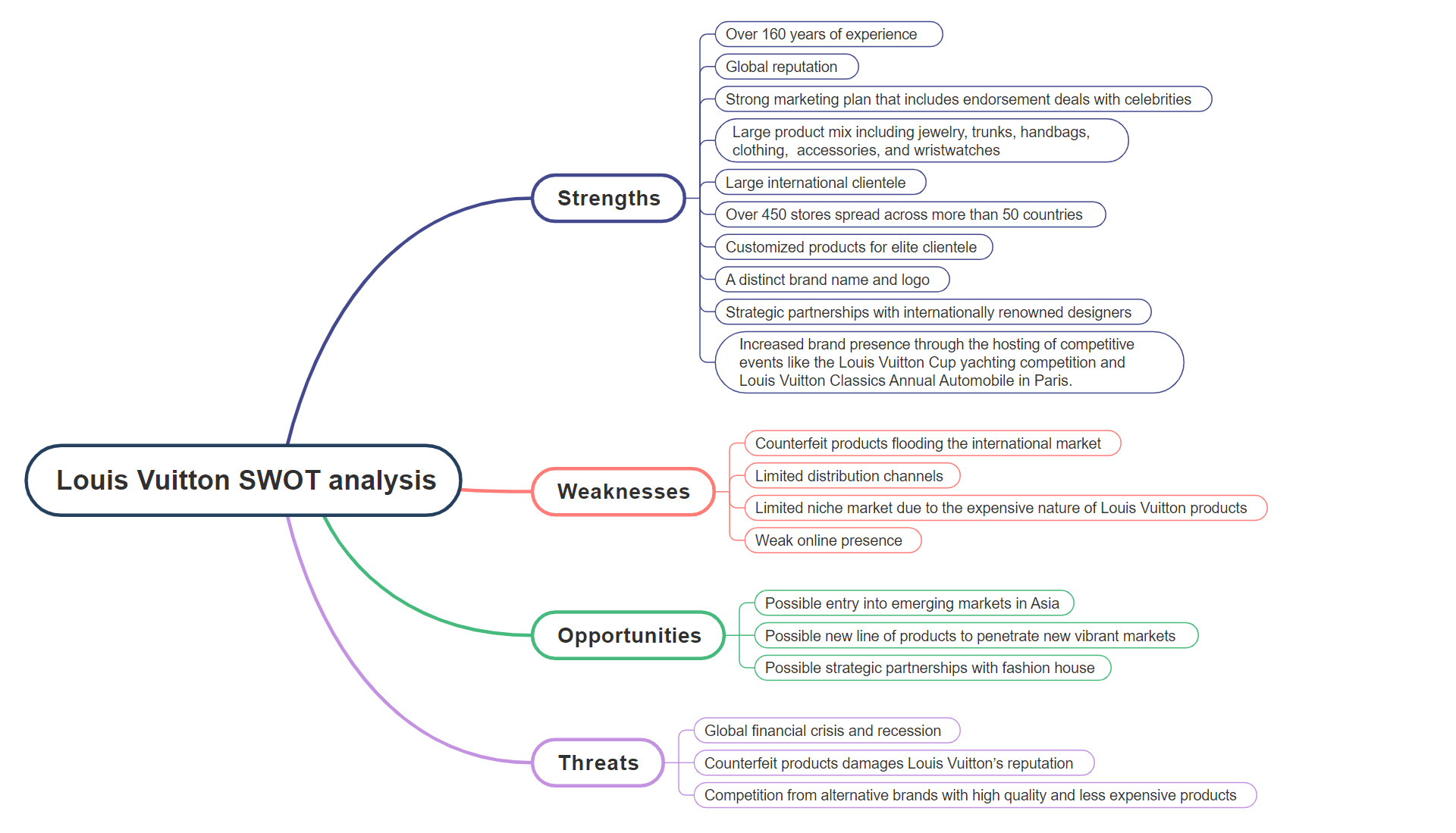Introduction
Louis Vuitton is one of the oldest and most successful brands for premium goods. This company was founded in Paris, France, by Louis Vuitton in 1854. And for over 165 years, Louis Vuitton has continued to evolve and stay relevant in today's world. Louis Vuitton is notably a luxurious goods company specializing in items like jewelry, wristwatches, clothing, accessories, handbags, leather goods, and trunks.
They have been able to carve a niche for themselves as a luxurious brand offering only premium quality, high-priced products. It is one brand that the wealthy upper class can undoubtedly relate to. This is evident in the brand's turnover and profit margin figures. As of 2020, Louis Vuitton raked in €14 billion in revenue from the sale of its eclectic product mix.
But what makes this luxurious goods production company so successful?
The Louis Vuitton SWOT analysis in this post provides answers to this question. SWOT is an acronym for Strengths, Weaknesses, Opportunities, and Threats. By knowing the SWOT analysis of Louis Vuitton, you will get a better understanding of what makes the brand tick.
Louis Vuitton Strengths
Louis Vuitton's strengths distinguish this brand from its competitors and give the company a competitive edge in the luxurious goods industry. Some of the main forces of Louis Vuitton include:
- Louis Vuitton is a company that has weathered the storm with over 160 years of corporate existence and experience.
- Louis Vuitton produces high-quality products. Both existing and prospective customers know that they can rely on this brand for premium quality luxury items.
- Louis Vuitton is a known name with a good reputation as a global brand with fantastic brand recall.
- Louis Vuitton has a strong brand presence with a distinct, easily recognizable logo which can be seen on all its products.
- Over time, Louis Vuitton has built a large following consisting of loyal customers worldwide.
- Louis Vuitton provides personalized services to customers by producing customized luxury items, especially for its very wealthy, elite clientele.
- A strong marketing plan involving the use of celebrity endorsements with world-renowned personalities from the film, sports, music, and fashion industry.
- A broad product mix comprising luxury items including jewelry, handbags, clothing, wristwatches, shoes, accessories, and trunks.
- Strategic partnerships with internationally renowned designers in the clothing & accessories, shoes, wristwatch, and jewelry industry.
- Over 450 retail outlets located in large-scale shopping malls in 50 + countries across the globe.
- Sponsorship of different events, including the annual Louis Vuitton Classics Annual Automobile in Paris and the Louis Vuitton Cup, a competitive yachting event.
Louis Vuitton's Weaknesses
Weakness is also an essential element of Louis Vuitton's SWOT analysis. It shows those aspects of their business that need improvements for market penetration, expansion, sales turnover, and revenue. Some of the known weaknesses of this luxury brand include;
- The distribution channels of Louis Vuitton are limited, as they sell items only through retail stores and outlets in shopping malls.
- Louis Vuitton is an expensive brand. The average person cannot afford to buy products of this brand. This limits the sale of its products to just the wealthy upper class and niche market.
- Many of the products of this brand are mainly influenced by French design and style. With less influence from other countries' innovation, style, and trends, the Louis Vuitton market is further streamlined to only those customers interested in French-styled luxury goods.
- Louis Vuitton is one of the most imitated brands around. The sale of fake Louis Vuitton imitations at cheap rates has created a new market of individuals who want affordable, low-quality products that look like the real deal with the Louis Vuitton logos. This can adversely affect Louis Vuitton's expansion into emerging new markets while also negatively impacting its sales and profit margins.
- A weak online sales presence coupled with the high demand for cheap imitations is fast creating a new market where fake Louis Vuitton products are supplied online to an eager young population, particularly Millenials and Gen Z. This new market cannot afford original Louis Vuitton products, so they settle for duds which they claim as accurate while showing off on social media platforms. This has the potential to hurt the reputation of the Louis Vuitton brand.
Louis Vuitton's Opportunities
The SWOT Analysis of Louis Vuitton is not complete without identifying possible opportunities that the brand could capitalize on to boost its sales revenues.
Here are a few opportunities that Louis Vuitton could explore;
- Louis Vuitton can attract a new generation of customers, particularly the millennials and Generation Z, by remodifying its brand reputation.
- Louis Vuitton can strategically engage in corporate collaborations, especially with those companies sharing similar customer groups or segments.
- Louis Vuitton can intensify their marketing drive and efforts by taking full advantage of the fast-growing Asian market in expanding its customer base, particularly in countries like India and China. However, it must be mentioned that Louis Vuitton has already established its presence in India and China with luxurious stores. Louis Vuitton also has a massive presence in Japan, especially amongst females in the country.
- Louis Vuitton can improve its competitive edge by developing new products and services.
- The brand can enhance its business by partnering with well-known fashion houses, an international chain of hotels, and popular Lifestyle events.
It is worth noting that the market for luxurious items is valued at about USD$42 billion and growing at an estimated annual rate of around 4%. Louis Vuitton can take advantage of this opportunity to position the brand further by expanding its product line to meet the needs of a much broader customer segment. In addition, Louis Vuitton can capitalize on the rising per capita income of many Asian countries. More of their population has more significant disposable income that could be spent buying the luxurious commodities that Louis Vuitton offers.
Louis Vuitton's Threats
What constitutes a threat to any brand like Louis Vuitton includes internal or external factors that can significantly endanger the operations, sales turnover, and business profits.
Some of the identified threats in the LVMH SWOT analysis include;
- The threat of financial crisis and global recession can adversely affect the survival and growth of the brand.
- The availability of more affordable alternative brands and luxury products.
- A drop in sales due to competition from other brands offering similar low-priced products.
- The presence of counterfeit products in the global market can negatively affect the image and market share of the brand.
- Changes in the international trade policies by the governments of countries where Louis Vuitton products are sold. This can disrupt the operations of the brand.
Mind Map

Key Takeaways
The Louis Vuitton SWOT analysis highlighted above suggests that the brand has a lot of strengths. For starters, Louis Vuitton is a known luxury goods brand with more than 160 years of experience. Also, the company already has a huge clientele consisting of wealthy elites that can afford the premium price of their products. But Louis Vuitton also has weaknesses, such as a weak distribution channel and online presence.
Nevertheless, there are several opportunities that the brand can capitalize on. The Asian market offers a huge potential for the company's growth. Asian countries like China and India are experiencing improved economies with rising per capita income and a population with more disposable income available to spend on luxury goods. While Louis Vuitton has many strengths that give it a competitive advantage, it still has to be cautious of possible threats to its business.
If you enjoyed this Louis Vuitton SWOT analysis, you could read it again in PDF format. Simply download the PDF file to your desktop computer using a reliable, convenient PDF reader like PDF Agile.
With PDF Agile, you can compress large PDF files. You can also convert other format documents to PDF format and vice-versa. This PDF reader provides you with effective editing functions. The text content and parts of a PDF file can be highlighted, while a bookmark and print function is available as well.
PDF Agile also has a redact option that allows you to delete content at will. Get your free download of PDF Agile here now, and always have access to this analysis whenever you want.
References
Comprehensive SWOT Analysis of Louis Vuitton by Aditya Shastri
https://iide.co/case-studies/swot-analysis-of-louis-vuitton/
SWOT analysis of Louis Vuitton
January 11, 2019 By Hitesh Bhasin
https://www.marketing91.com/swot-analysis-louis-vuitton/





